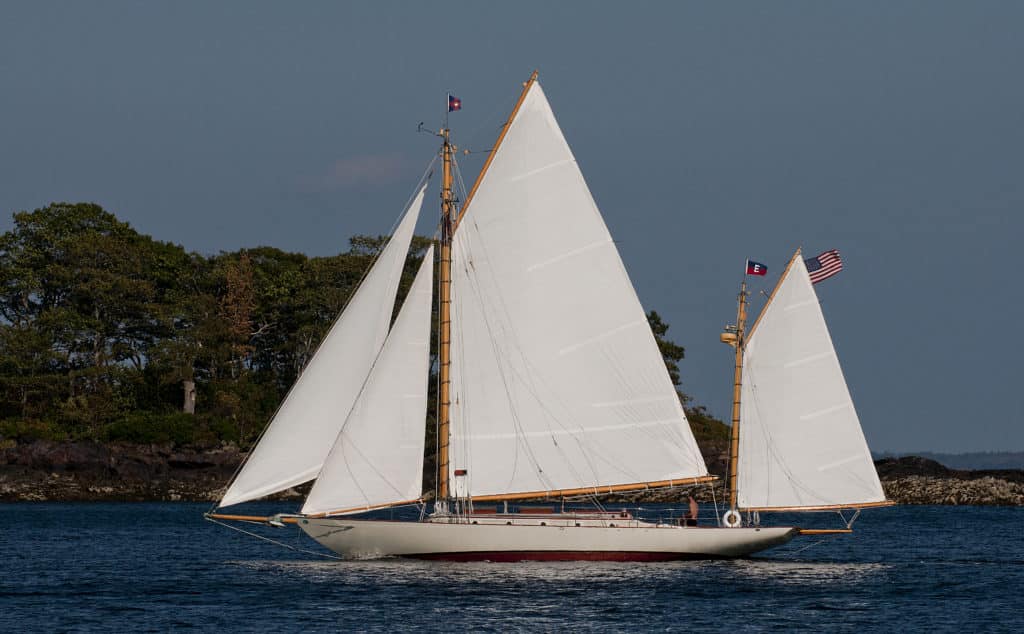
The Maine coast twists, turns inward and outward, and spills offshore, creating one of the world’s most interesting destinations to explore by sailboat. The largest of the many sounds and bays, Penobscot Bay, presents a panorama of islands large and small, winding passages, tight harbors and quiet towns.
On a scintillating day in mid-October, we steered our Mason 44, Frances B, across the mouth of Blue Hill Bay and turned northwest toward Eggemoggin Reach, the eastern border of Penobscot Bay. In the clear fall air, a crowd of islands stood sharp against the mainland, their forested shores bright green against misty blues of distant hills. For centuries artists have come to Maine to paint seascapes of wild waves, jagged islands and sailing ships. Afraid to lose the particularly inspiring light of the changing seasons, many stayed to live here. Jerry Rose, a friend of ours and a painter of exceptional talent, settled on Benjamin River, which side-steps from Eggemoggin Reach. He lives across the bay from WoodenBoat magazine’s school of boatbuilding — a very fitting neighbor, since some decades ago Jerry built himself a Herreshoff-designed double-ender to sail to the Bahamas. For many years he painted Bahamian sailing smacks, their sailors and their families — a career reminiscent of Maine artist Winslow Homer’s.
From Benjamin River, Frances B headed northwest again, beating against the cool northerlies over smooth waters in the lee of dense forests of fir, spruce and birch. Steering with light finger pressure on the wheel, I leaned back and relaxed with my wife, Nancy. There was no particular need to keep lookout, as the lobster-trap buoys that litter most of Maine’s waters had vanished. The crustaceans, so ubiquitous everywhere else, don’t like the muddy bottom in the Reach. But let’s not forget that lobsters are the main crop here. In Castine Harbor, with its strong currents and great depths, we picked up a mooring off Eaton’s Boatyard. Kenny Eaton took the money for the mooring, then surprised us with a gift of live lobsters — the best deal of the season.
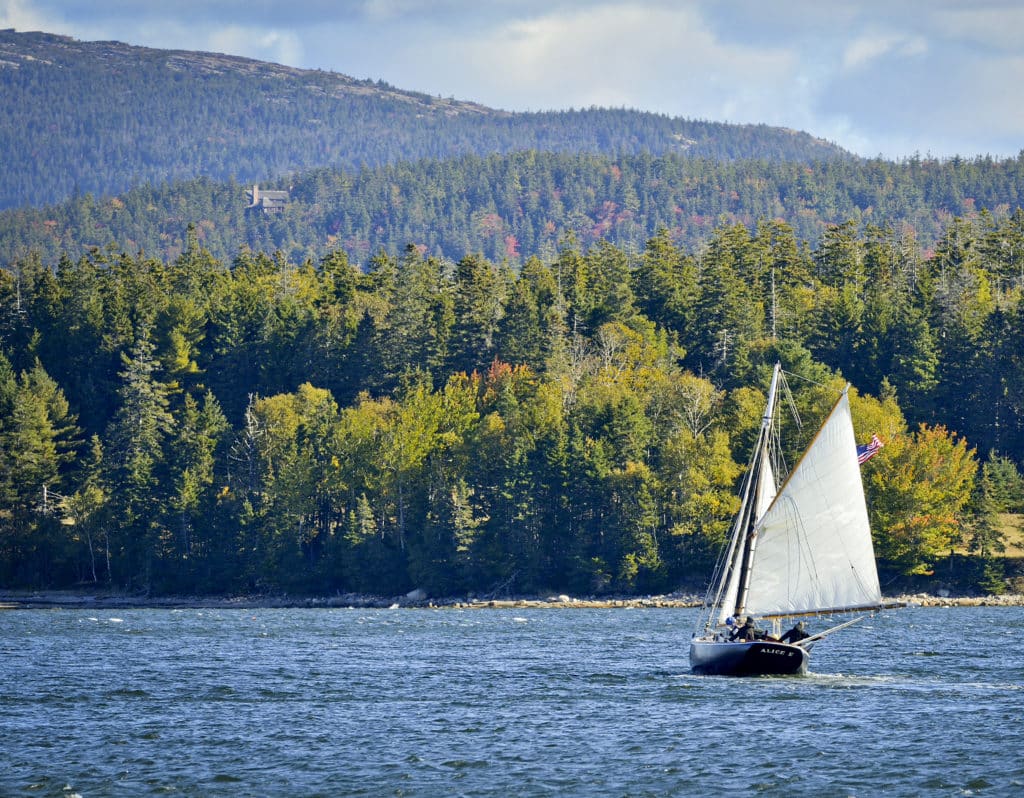
The modest town of Castine is old, predating even Plymouth Colony. First a fur trading post, it later expanded as a source of timber for navy ships. The British, French and even the Dutch battled for it. During the Revolutionary War, a confrontation between the British Navy and the U.S.’s Penobscot Expedition cost America 41 vessels, the worst U.S. Navy loss until Pearl Harbor. In the 19th century, Castine became a shipbuilding town. However, only a stone marker remains of the Noyes shipyard, which between 1835 and 1872 launched more than 60 vessels, clipper ships among them. State of Maine, the large freighter that now sits along the Maine Maritime Academy waterfront, is used as a training ship for students. Bowdoin, a schooner moored nearby and also owned by MMA, stirred our memories. Twice in northern Labrador we have sought shelter in Bowdoin Harbour, so named to celebrate over 20 Arctic voyages the schooner made under the command of Capt. Donald B. MacMillan.
Much as Castine was quiet, Camden, on the western shore of Penobscot Bay, was humming. Although the inner harbor was packed tight with yachts, traditional schooners still came to their customary wharves, many without auxiliary power, helped only by the small yawlboat they tow. With the end of commercial sailing in the 1950s, several schooners, some launched in the late 1800s, began taking paying passengers for recreational sails. Today a dozen of them are busy chartering, their sails — some tanbark red — turning Penobscot Bay into a canvas from the past.
Considering the small size of the town, the number of vessels that have hit Camden’s waters over the years is staggering. Some 70 boats were launched from just one yard owned by Joseph Stetson, which opened in 1816 and carried on for 40 years. Faced with labor problems (shipwrights who took swigs of rum while banging timber with adzes), he introduced the “coffee break,” now a hallowed employee perk the world over. Many of the ships built in Camden were big. In 1905, Holly M. Bean’s yard launched a five-masted schooner, and had 64 vessels to its credit before closing in 1920. Today, on the same site, yachts are still serviced at Lyman-Morse Boatbuilding Co.’s Wayfarer Marine campus. At one point Tom Watson of IBM was one of the yard’s three owners. An active sailor, he probably thought the best way to keep his yachts shipshape was to own a repair facility. He owned a fleet of Sparkman & Stephens-designed beauties all named Palawan, which he sailed to northern Greenland, across Hudson Bay, and to Antarctica, among other destinations, earning the Cruising Club of America’s Blue Water medal in 1986.
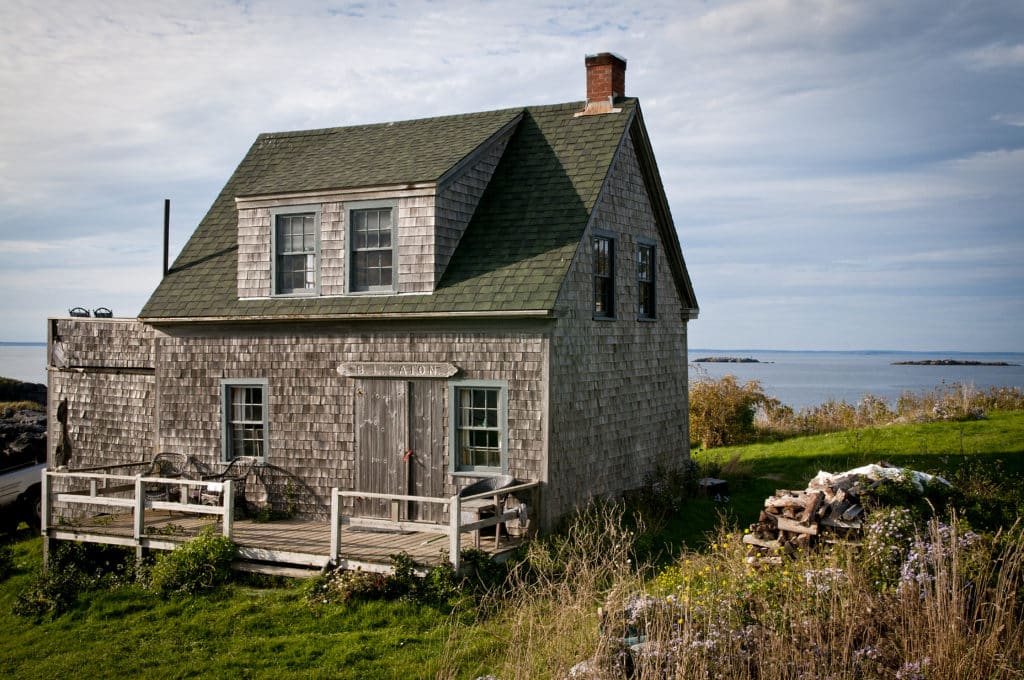
Camden still attracts legendary yachts. At the Wayfarer docks we saw Sumurun, a 94-foot Fife ketch from 1914, and another Fife, the 52-foot 1912 yawl Dione, preparing for the Northwest Passage. We swung by right when Seminole, a 58-foot yawl designed by W. J. McInnis and built in 1916 by Lawley & Sons, was tying up after the last trip of the season. Seminole is owned by Elizabeth Meyer of J-class fame. Spectacular modern classics turn up here, too. The Bill Langan-designed 130-foot Huckleberry (formerly Victoria of Strathearn), built by Alloy Yachts, is a regular.
We had our mind set on a visit to Monhegan Island, about 10 miles off the mainland. It figures prominently in the history of both exploration and art history. Monhegan’s anchorage is untenable in southerly winds and swell, so while waiting for fair weather, we sailed to the Fox Islands. With a forecast of strong northeast winds, we sheltered in a bay in the islands’ Thorofare, a passage separating North Haven and Vinalhaven. In the afternoon we had a bleachers view of the trimaran Flying Fish, a Chris White-designed Hammerhead 54, which in the rising pre-frontal southerly literally flew over the smooth waters of the Thorofare.
The next day the northeasterly dropped to 15 knots, and Frances B took off toward the west coast of Penobscot Bay, on to Owls Head and a squeeze through Muscle Ridge Channel. Hundreds of lobster boats dotted the coves along the western shore. Ahead on the clear horizon, Monhegan appeared, recognizable by its whaleback silhouette. The slot between Monhegan and the smaller Manana Island, which passes for a harbor, receives some protection, but even the larger Monhegan is only 1.7 miles long. The bottom is rocky, and the junk of centuries makes for uneasy anchoring. We gratefully picked up one of the moorings reserved for visiting yachts.
For a couple of centuries, the few families that lived on Monhegan did well fishing cod, once fabulously plentiful. The island was also safer than the mainland settlements, which suffered from Native American raids. In the mid-1800s, two roaming artists happened upon Monhegan. Ocean swells pounded the high cliffs facing the Atlantic, spray flew, and low clouds tore through gnarly forests — inspirational drama was at hand. The word spread, and eventually big names of the art world followed. Robert Henri, Winslow Homer, Rockwell Kent, Edward Hopper and multiple generations of Wyeths all painted here, producing exquisite work.
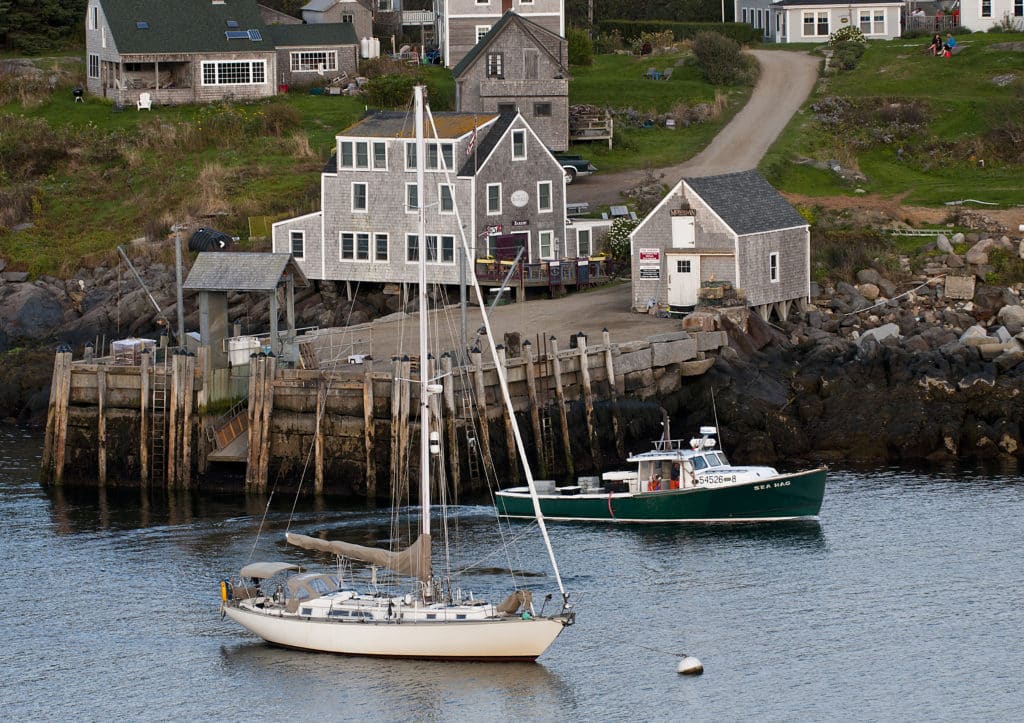
Today, day-trippers arrive, some motivated by nostalgia, others to explore the galleries of the resident artists. Less than a dozen local boats continue lobstering. We went off on some of the 18 trails that cross the island from the village to the Atlantic shore. The terrain felt wild as up and down we traipsed from one rocky point to another through tangled woods. Now and then we picked apples off the trees marking the site of a homestead long since gone.
Reading tall tales from exploring scribes can actually get you to interesting places. Capt. Weymouth’s expedition from England arrived on Monhegan in May 1605. They went ashore to get firewood, feasted on wild fowl, cod and haddock, and then crossed to the mainland and sailed into a river that the ship’s clerk compared to the Orinoco, Seine and Loire — a case of false advertising. It’s now called St. George River, and only 10 miles from the entrance, we reached the end of navigation at the waterfront of Thomaston. The view ahead seemed to belong more to Newport, Rhode Island: a bright red Swan 100, a 29-meter Frers, a Hinckley Sou’wester 70 glowing in varnish like a Stradivarius violin. We arrived at Lyman-Morse’s Thomaston campus, and it looked impressive.
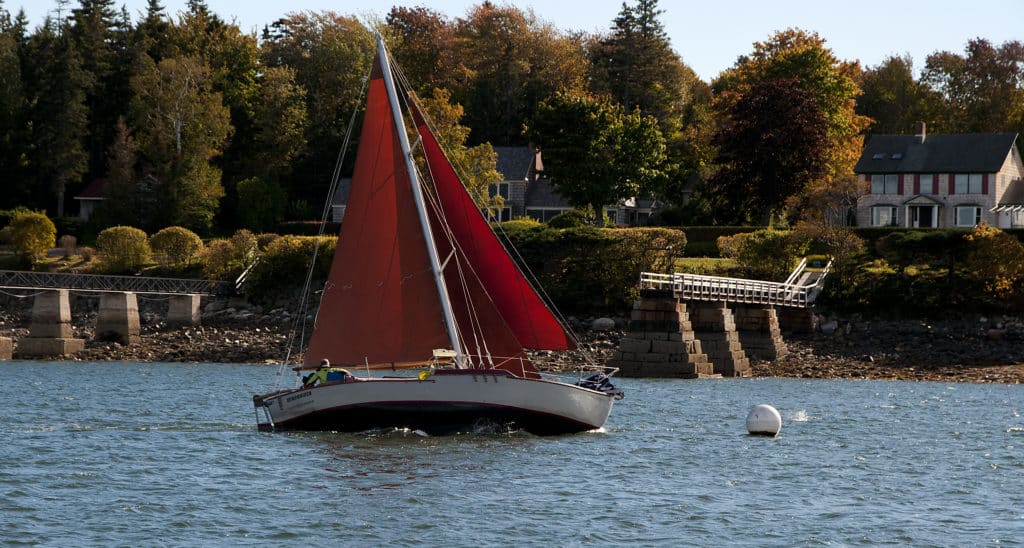
The old Morse Boatbuilding Co. of Thomaston built a lot of Friendship sloops and Alden schooners. Then, in 1978, Cabot Lyman, fresh from sailing across the Atlantic and cruising the Med, burst on the scene, bought the place and brought in new ideas. Very soon the yard was building S&S-designed Seguin 40s, 44s and 49s — a series of high-end, semicustom, good-looking, fast and yet supremely seaworthy bluewater sloops. To prove it, Lyman took his wife and three very young sons on a circumnavigation. By 2013, when we visited, Lyman-Morse had launched almost 100 boats, sail and power, and Lyman himself had cruised and raced over 150,000 miles, surely a record among boatbuilders. As we toured the facilities, we learned about the SCRIMP resin-infusion system that the yard employs, and which is said to produce immensely strong yet light structures with virtually no pollution. Designs built at Lyman-Morse have come from Frers, Chuck Paine, Sparkman & Stephens, Reichel/Pugh, Bruce Farr and even Morrelli & Melvin, which specializes in wave-piercing catamarans. Whereas new ships once slid down a muddy riverbank, here the emphasis on cleanliness and quality working conditions has led to well-lit, climate-controlled, environmentally friendly buildings. The structures are big — one of them opens to admit a 40-foot-wide 110-ton Travelift that can accommodate a 150-foot boat.
Up a gentle hill from the boatyard, we walked through the streets of old Thomaston, carpeted with fall leaves and lined with perfectly tended homes from the 1800s. The census of 1840 listed seven millionaires in the whole of the United States, two of them boatbuilders from Thomaston; the town still looks comfortably well-to-do.
If there are any ugly boats in Maine, we didn’t see them. What we did glimpse were Friendship sloops, schooners, yachts from robber-baron days and the Roaring 20s, and racing sleds large and small. And they all spread their wings in these waters nature surely crafted for sailing. On this coast, especially between Mount Desert Island and Muscongus Bay, a sailboat will always find free wind over smooth water to let her rip along. And at the end of the day, there will always be a calm cove with a fragrant forest to windward.
Tom Zydler and his wife, Nancy, are preparing Frances B for their third trip to Greenland and Labrador.








